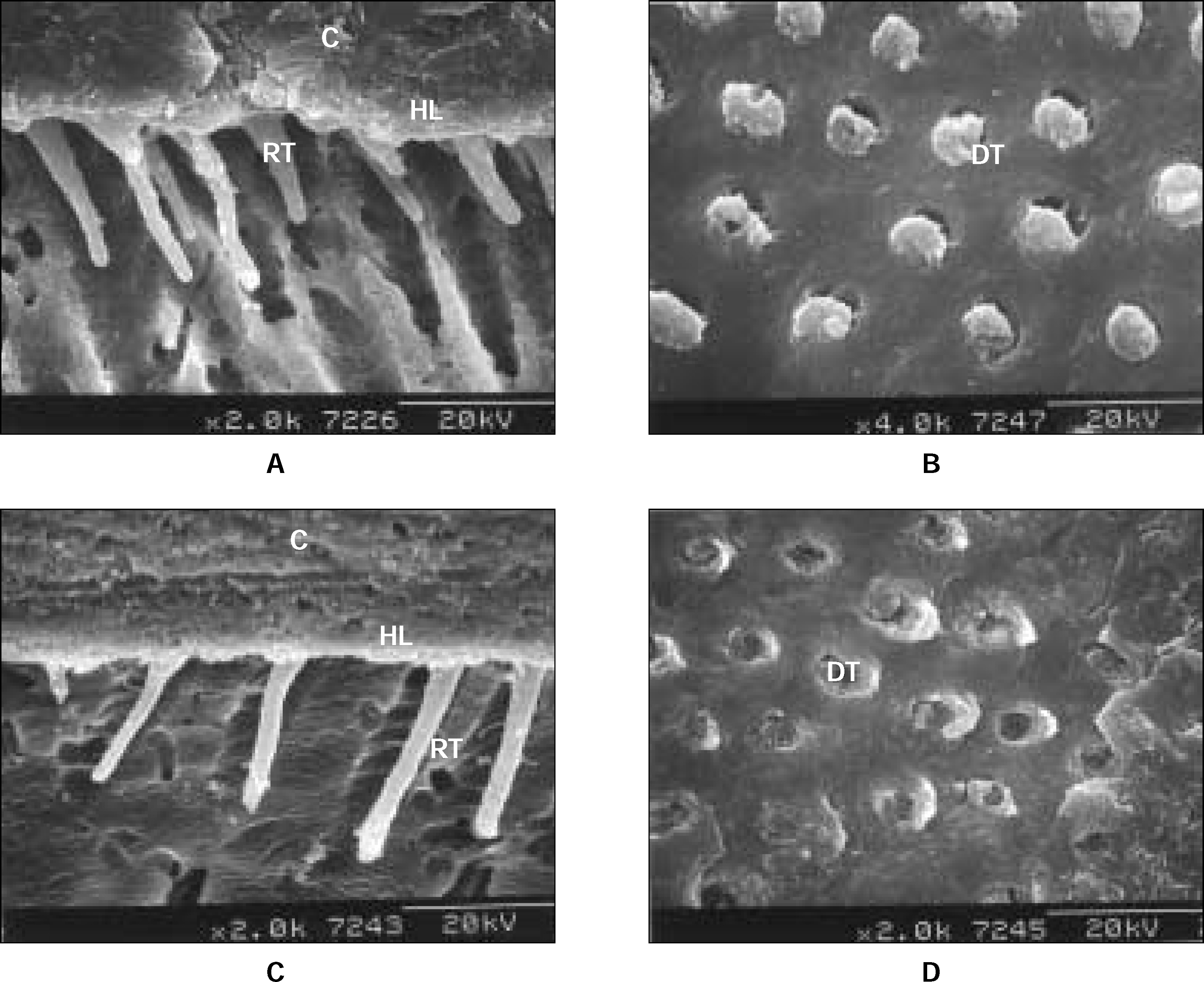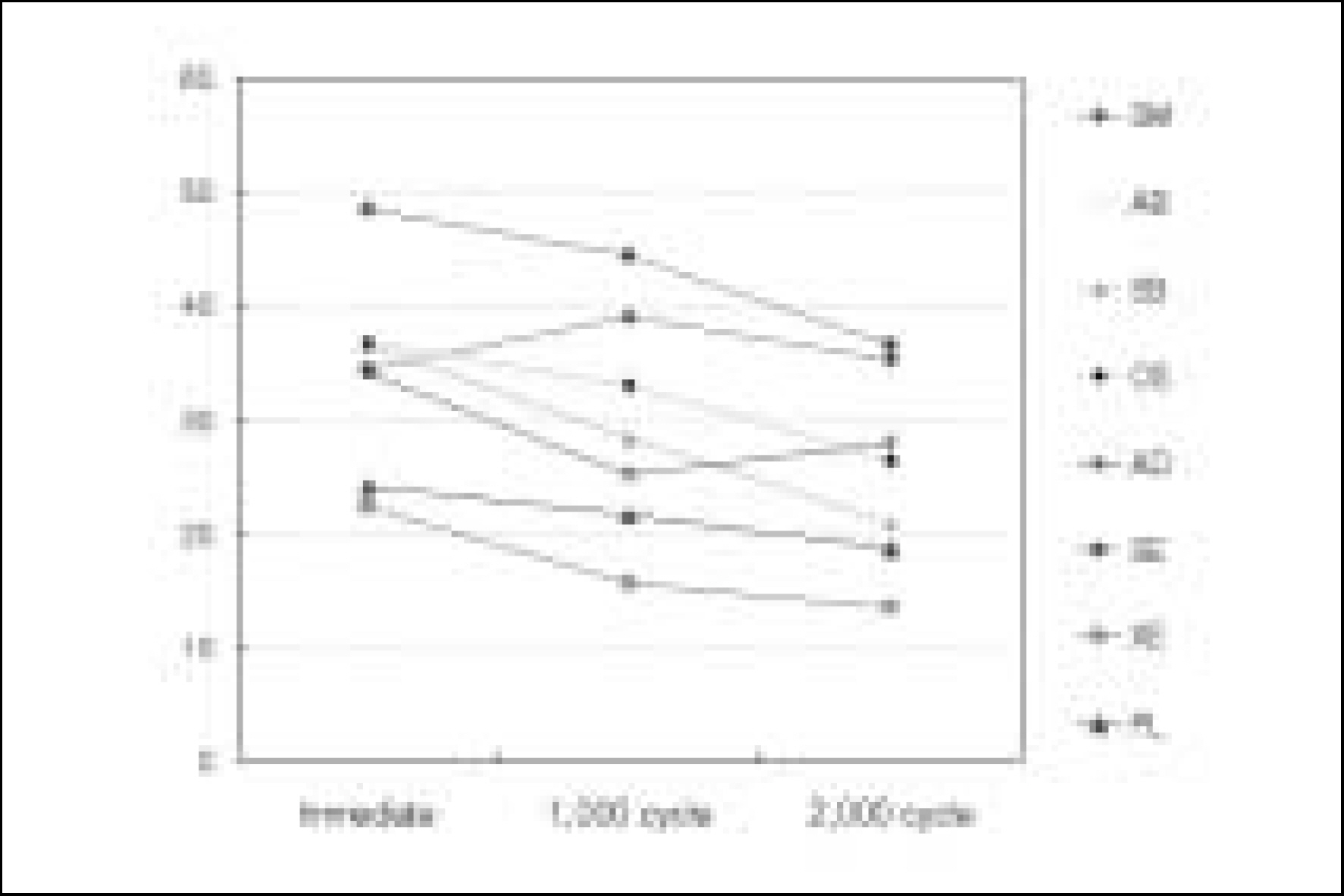References
1. Raskin A, Mechotte-Theall B, Vreven J, Wilson NH. Clinical evaluation of a posterior composite 10-year report. J Dent 27:130–19.
1999;
2. Wilder AD, May KN, Bayne SC, Taylor DF, Leinfelder KF. Seventeen year clinical study of ultraviolet-cured posterior composite class I and II restorations. J Esthetic Dent 11:135–142.
1999;
3. Sano H, Takatsu T, Ciucchi B, Horner JA, Matthews WG, Pashley DH. Nanoleakage: leakage within the hybrid layer. Oper Dent 20:18–25.
1995;
4. Yoshida Y, Van Meerbeeek B, Nakayama Y, Snauwaert J, Hellemans L, Lambrechts P, Vanherle G, Wakasa K. Evidence of chemical bonding at biomateri-al?hard tissue interfaces. J Dent Res 79:709–714.
2000;
5. Primenta LAF, Amaral CM, Bredrane de Castro AKB, Ritter AV. Total-etch, deproteinization and self-etching. Oper Dent 29:592–598.
2004;
6. Paul SJ, Welter DA, Ghazi M, Pashley D. Nanoleakage at the dentin adhesive-interface vs. microtensile bond strength. Oper Dent 24:181–188.
1999;
7. Giannini M, Seixas CAM, Reis AF, Pimenta LAF. Six-month storage-time evaluation of one-bottle adhesive systems to dentin. J Esth Rest Dent 15:43–49.
2003;
8. Tay FR, Pashley DH, Yoshiyama M. Two mondes of nanoleakage expression in single-step adhesives. J Dent Res 81:472–476.
2002;
9. Carracho AJL, Chappell RP, Glaros AG, Purk JH, Erick JD. The effect of storage and thermocycling of the shear bond strength of three dental adhesive. Quintessence Int 22:745–752.
1991;
10. Marshall GW, Marshall SJ, Kinney JH, Balooch M. The dentine substrate: structure-and properties related to bonding. J Dent 25:441–458.
1997;
11. Ferracane JL, Berge JR, Condon JR. In vitro aging of dental composites in-water-effect of conversion, filler volume, and filler/ matrix coupling. J Biomed-Mater Res 42:465–472.
1998;
12. Gale MS, Darvel BW. Thermal cycling procedures for laboratory testing of dental restorations. J Dent 27:89–99.
1999;
13. Sano H, Yoshikawa T, Pereira PNR, Kanemura N, Morigami M, Tagami J, Pashley . Long-term Durability of dentine bonds made with a self-etching primer, in vivo. J Dent Res 78:906–911.
1999;
14. Tanumiharja M, Burrow MF, Tyas MJ. Microtensile bond strengths of seven-dentine adhesive systems. Dent Mater 16:180–187.
2000;
15. Burrow MF, Satoh M &, Tagami J. Dentin bond durability after three years using a dentin bonding agent with and with-out priming. Dent Mater 12(5):302–307.
1996;
16. Li HP, Burrow MF, Tyas MJ. The effect of long-term storage on nano-leakage. Oper Dent 26:609–616.
2001;
17. Tay FR, Pashley DH, Suh BI, Carvalho RM, Itthagarun A. Single-step adhesives are permeable membranes. J Dent 30:371–382.
2002;
18. Kanca 3rd J, Gwinnett AJ. Successful marginal adaptation of a dentin-enamel bonding system in vitro and vivo. J Esthet Dent 6:286–94.
1994;
19. Nakajima M, Kanemura N, Pereira PN, Tagami J, Pashley DH. Comparative microtensile bond strength and SEM analysis of bonding to wet and dentin. Am J Dent 13:324–8.
2000;
20. Reis A, Loguercio AD, Carvalho RM, Grande RH. Durability of resin dentin interfaces: effects of surface moisture and adhesive solvent component. Dent Mater 20(7):669–76.
2004;
21. Reis A, Loguercio AD, Azevedo CLN, Carvalho RM, Siger JM, Grande RHM. Moisture spectrum of demineralized dentin for different solvent -based adhesive system. J Adhes Dent 5:183–192.
2003;
22. Takahashi A, Inoue S, Kawamoto C, Ominato R, Tanaka T, Sato Y, Pereira PNR, Sano H. In vivo longterm durability of the bond to dentin using two adhesive systems. J Adhes Dent 4:151–159.
2002;
23. Miyazaki M, Sato M, Onose H, Moore BK. Influence of thermal cycling on dentin bond strength of two-step bonding systems. Am J Dent 11:118–122.
1998;
24. Nikaido T, Kunzelman KH, Chen H, Ogata M, Harada N, Yamaguchi S, Cox CF, Hickel R, Tagami J. Evaluation of thermal cycling and mechanical loading on bond strength of a self-etching primer system to dentin. Dent Mater 18:269–275.
2002;
25. Shirai K, De Munck J, Yoshida Y, Inoue S, Lambrechts P, Suzuki K, Shintani H, van Meerbeek B. Effect of cavity configuration and ageing on the bonding effectiveness of six adhesives to dentin. Dent Mater 21:110–124.
2005;
26. 조영 곤, 반일 환, 유미 경. 상아질 접착 후 저장기간에 따른 접착 제의 접착력의 변화. 대한치과보존학회지 30(3):204–205.
2006;
27. Kato G, Nakabayashi N. The durability of adhesion to phosphoric acid etched, wet dentine substrates. Dent Mater 14:347–352.
1998;
28. International Organization for Standardization. ISO TR 11405, Dental materials-guidance on testing of adhesion to tooth structure 1994;
29. Hashimoto M, Ohno H, Kaga M, Endo K, Sano H, Oguchi H. In vivo degradation of resin-dentin bonds in humans over 1 to 3 years. J Dent Res 79:1385–1391.
2000;
30. Fumiaki K, Takafumi O, Tetsuo I, Naoyuki M. Influence of thermal cycles in water on flexural strength of laboratory-processed composite resin. J Oral Rehabil :703–707.
2001;
31. Hakimeh S, Vaidyanathan J, Houpt ML, Vaidyanathan TK, Hagen SV. Microleakage of compomer class V restorations: effect of load cycling, thermal cycling, and cavity shape differences. J Prosthet Dent 83:194–203.
2000;
32. Wendt SL, Mcinnes PM, Dickinson GL. The effect of therm- cycling in microleakage analysis. Dent Mater 8:181–184.
1992;
33. Krejci I, Lutz F. Mixed class V restorations: the potentials of dentine bonding agent. J Dent 18:263–270.
1990;
34. Nakajima M, Ogata M, Okuda M, Tagami J, Sano H, Pashley DH. Bonding to caries-affected dentin using self-etching primers. Am J Dent 12:309–314.
1999;
35. Tay FR, Pashley DH. Dental adhesives of the future. J Adhes Dent 4:91–103.
2002;
36. De Munck J, Van Landuyt K, Peumans M, Poitevin A, Lambrechts P, Braem M, Van Meerbeek B. A critical review of the durability of adhesion to tooth tissue: methods and results. J Dent Res 84(2):118–32.
2005;
37. Frankenberger R, Strobel WO, Lohbauer U, Kramer N, Petschelt A. The effect of six years of water storage on resin composite bonding to human dentin. J Biomed Mater Res Part B: Appl Biomater 69(1):25–32.
2004;
38. 장 영인, 최 경규, 박 상진. 복합레진에 대한 자가부식형 접착제의 적합성에 관한 연구. 대한치과보존학회지 31(in process) 2006;
39. Armstrong SR, Vargas MA, Fang Q, Laffoon JE. Microtensile bond strength of a total-etch 3-step, total-etch 2-step, self-etch 2-step, and a self-etch 1-step dentin bonding system through 15-month water storage. J Adhes Dent 5:47–56.
2003;
40. Tay FR, Gwinnett JA, Wei SH. Relation between water content in acetone/alcohol-based primer and interfacial ultrastructure. J Dent 26:147–156.
1998;
41. Choi KK, Condon JR, Ferracane JL. The effects of adhesive thickness on polymerization contraction stress of composite. J Dent Res 79:812–817.
2000;
42. Yoshida Y, Nagakane K, Fukuda R, Nakayama Y, Okazaki M, Shintani H, Inoue S, Tagawa Y, Suzuki K, De Munck J, Van Meerbeek B. Comparative study on adhesive performance of functional monomers. J Dent Res 83(6):454–8.
2004;
43. Burrow MF, Harada N, Kitasako Y, Nikaido T, Tagami J. Seven-year dentin bond strengths of a total-and self-etch system. Eur J Oral Sci 113(3):265–70.
2005;
44. Brackett MG, Dib A, Brackett WW, Estrada BE, Reyes AA. One-year clinical performance of a resin- modified glass ionomer and a resin composite restorative material in unprepared Class V restorations. Oper Dent 27(2):112–6.
2002;
45. Tu¨rku¨n SL. Clinical evaluation of a self-etching and a one-bottle adhesive system at two years. J Dent 31:527–534.
2003;
46. Hashimoto M, Ohno H, Sano H, Kaga M, Oguchi H. Degradation patterns of different adhesives and bonding procedures. J Biomed Mater Res Part B: Appl Biomater 66(1):324–30.
2003;
47. Tay FR, King NM, Suh BI, Pashley DH. Effect of delayed activation of light-cured resin composites on bonding of all-in-one adhesives. J Adhes Dent 3(3):207–25.
2001;
48. El Zohairy AA, De Gee AJ, Hassan FM, Feilzer AJ. The effect of adhesives with various degrees of hydrophilicity on resin ceramic bond durability. Dent Mater 20:778–787.
2004;
49. Carrilho MR, Carvalho RM, Tay FR, Pashley DH. Effects of storage media on mechanical properties of adhesive systems. Am J Dent 17(2):104–8.
2004;
50. Yiu CK, King NM, Pashley DH, Suh BI, Carvalho RM, Carrilho MR, Tay FR. Effect of resin hydrophilicity and water storage on resin strength. Biomaterials 25:5789–96.
2004;
51. Yiu CK, King NM, Carrilho MR, Sauro S, Rueggeberg FA, Prati C, Carvalho RM, Pashley DH, Tay FR. Effect of resin hydrophilicity and temperature on water sorption of dental adhesive resins. Biomaterials 27(9):1695–703.
2006;










